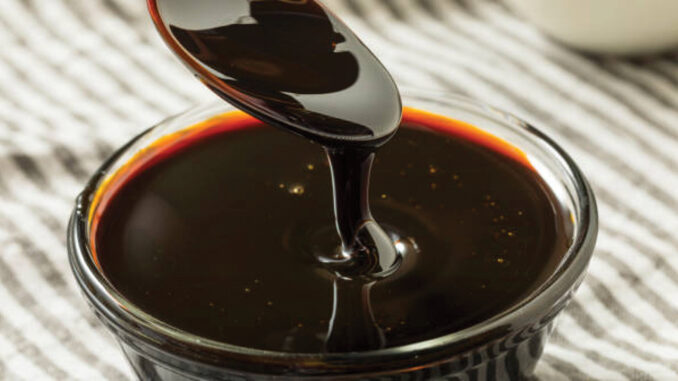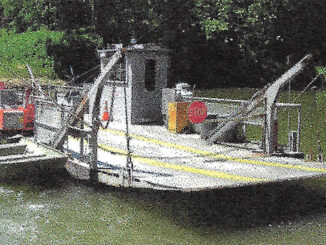
Yesterday was a puttering day. No meetings, no medical appointments, no commitments. Just a lazy, drifting, puttering day! Let’s see. The refrigerator has already been explored… the pantry, too. The clothes closet? Nah, that takes too much time and energy. Some other day, maybe. Maybe the kitchen cabinets! Not this one – it’s only dishes. More dishes next. Not interested. Whoah!??? What are all those things stacked behind that door? Black pepper. Beef bouillon cubes. Sugar and cinnamon. Ooops. Back off the floor, there are chicken bouillon cubes. Italian seasoning. Lemon pepper – need to leave that out. It’s good. Ground nutmeg. Garlic powder. Ah ha!!! Old friend, you are hiding at the back of the shelf. You haven’t been seen since Christmas gingerbread cookies two holidays ago. Come on out, Molasses, and let’s reminisce together.
There was a period in the lifestyle of the early settlers when molasses and honey were important mealtime items. Through the 19th century, molasses was the most popular sweetener in the United States. Refined sugar, white sugar, was available toward the end of the century but was much more expensive. At the end of World War 1 the prices dropped dramatically and molasses took a back seat as the preferred sweetener. The familiar burn-off method of making the sweetener continued with some settlers. (This writer, when teaching in the 1960s, had the opportunity to take the class to a farm in the Anna community to observe the family making molasses just as the pioneers did.)
The old-fashioned way of making the sweetener was often an event involving neighbors, as lots of people, usually children, too, were needed to man the different tasks. Of course, the preparations began in the spring when the sugar cane seeds were planted along with potatoes, tomatoes, corn and other garden crops. The full-grown sugar cane plant would grow taller than the farmer. In the fall, the leaves of the cane were clipped off so nothing but the stalk was used in the milling process. The heads, full of seeds for next year’s crop, were cut off and saved.
On the making of the first batch of molasses, the pit is ready, the fire is started and the woodpile nearby is stacked high. It takes a steady fire to heat the brew. The cane stalks piled on one side will constantly be kept full as the stalks are fed into the mill. After the juice is pressed out, the cane proceeds forward to the other side. As the canes collect on the back side, they must be removed and carried away from the mill. Later, the used stems will be used for landscaping, to prevent erosion of the soil or some other practical use. This feeding of the stalks is performed in timing with the mule hitched to the crossbar and constantly walking the same path ‘round and ‘round the circle allowing the mill to grind the stalks and release the liquid.
The most experienced worker is needed for the stirring of the brew. The juice from the compressed stalks lands in a large kettle over the slow, steady fire in the pit. The green liquid in the vat must be stirred continuously with a wooden paddle. As the juice turns darker, it becomes thicker. From early morning until late in the evening, the process continues. Celebration of the first run of the molasses follows the continuous working, watching and waiting. Pones of cornbread and potato biscuits covered in sweet, thick juice are eaten eagerly.
Molasses as a food item has been known to exist in India at around 500 B.C. From this setting it spread very slowly until the Arab invaders brought it to Europe via Spain. It became popular in the West Indies and was sold to England, where they used it to make rum. In America, it was the sweetener of choice and was preferred by the settlers for enhancing the taste of collards, grits, biscuits and cornbread, and even popcorn. The forerunner of pecan pie was naturally the molasses pie. Chefs in North and South Carolina featured molasses in their menu listings: pork cracklings sprinkled on a sweet potato and molasses cupcake, or boneless grilled pork chops drizzled with molasses bourbon glaze.
Refineries were built to process tons of molasses and shipping tankers unloaded frequently in the coastal states by 1900. Molasses was difficult to ship safely. The liquid was usually housed in barrels, but extreme summer heat would cause the barrels to break open. The barrels had to be monitored and eventually opened while in storage. The city of Boston experienced the deadly power of over-housed molasses on January 15, 1919. Known as the Great Molasses Flood of 1919, its story was carried later in newspapers to southern Kentucky residents.
In Boston, a shipment of the sugary-sweet contents was stored for use in producing alcohol for liquor and munitions manufacturing. The syrup was placed in a 50-foot-tall steel holding tank located on Commercial Street in the north end of Boston. The tank often groaned and had some leakage regularly. On January 15, the holding tank burst, sending 2.3 million gallons of the sticky substance out into the streets. There was a fifteen-foot wall of the dark-brown sludge covering the street. Buildings fell, cars and trucks drowned, animals smothered, and people were buried, along everything else in its path.
So, our friend, Molasses, you have quite a history in the settling of this new world as well as your existence in Europe and Asia. Before you go, let me ask, “What is the difference between sorghum and molasses? Are they the same?” They are processed similarly but sorghum is made from sorghum cane and molasses is made from sugar cane or sugar beets. Sorghum is usually more flavorful while molasses is thicker, less expensive, and great for baking.

Thanks, Molasses, for a pleasant day of puttering. In today’s world you will probably still be placed in the future on the back of the kitchen shelf, but nothing can take away the value you have had and still have.
-by Mary Alice Oliver
About the Author: Mary Alice Oliver is a Bowling Green native who is a 1950 graduate of Bowling Green High School. She retired from Warren County Schools after 40 years in education. Visiting familiar sites, researching historical records and sharing memories with friends are her passions.







